
In early December 2020 it was a grey cold weekday (with wet snow later), but nonetheless I had the “Wandering Sickness” and decided to go straight up William Street in lower Manhattan, for the sole reason that I had not covered its length before. I have encountered it plenty of times, since when heading for the Seaport for a cheap tuna pasta lunch at Pier 17 (alas, I can’t do that anymore) I would get off the #2 train at William and Fulton. Four paralleling streets in Lower Manhattan have subway trains under them: Trinity Place (R), Broadway (4, 5), Nassau Street (J) and William (2, 3). And, until the els on Greenwich and Pearl Street were torn down, there were 6 parallel streets in a very narrow part of the island with subways or els!
William Street and Beekman, which crosses it, are named for Willem Beeckman, who arrived from Holland in 1647 on the same ship as Peter Stuyvesant. Originally a Dutch West India Company clerk, he later served nine terms as NYC mayor, when terms were a lot shorter than they are now. A descendant, James Beekman, owned the uptown Mount Pleasant mansion in whose vicinity Nathan Hale was hanged during the Revolutionary War, and that site is marked by Beekman Place.
William Street today runs from Hanover Square north to Spruce, but formerly ran somewhat longer, all the way to Pearl just south of Park Row. The northern end is now occupied by Pace University, Brooklyn Bridge-East River Drive ramps, and One Police Plaza. Buildings on that missing section of William Street, with house numbers above #170, can be seen on these 1940 tax photos.
no images were found
William Street runs north from Hanover Square, which is the name of the plaza on Pearl and also a short street running south from William Street to Water. Though NYC decided to dump most of its street and place names that were reminiscent of the British occupation during the War for Independence, there are exceptions such as Hanover Square, named for the family name of the British monarchical family. Politicians in the early 1800s tried to expunge it but Hanover Street and Square became permanent in 1830.
The wedge of territory on Pearl and Williams was also called Hanover Square and became a park in 1951. Changes instituted in the 1970s closed the north side of Pearl to traffic and converted it to pedestrian use. For 30 years a statue of William DePeyster, Dutch Colonial 17th-Century New Amsterdam mayor, was located here but was moved uptown to Thomas Paine Park just east of the intersection of Lafayette and Worth Streets in 2006. Like Civic Virtue, the city has never known quite what to do with Old Bill.
Why was Bill moved uptown? In 2006 Queen Elizabeth II (1926-2022) visited New York City and dedicated the QEII September 11 Garden, in honor of members of the British Commonwealth who were killed during the terrorist attack. The square was given a complete makeover:
The garden is based on a plan by English landscape designers Julian and Isabel Bannerman and combines the historic footprint of this public square with the silhouette of the British Isles. Master sculptor Simon Verity carved and engraved the undulating Morayshire sandstone inlay, quarried from the highlands of Scotland. The coping is inscribed with the shires of the British Isles—from Aberdeen in the north to Portland in the south. The large, rounded ‘Braemar’ stone, from a riverbed near Queen Elizabeth II’s home in Balmoral, sits in the garden’s south end, marking the distance from Aberdeen to New York.
Garden designers Lynden B. Miller and Ronda M. Brands worked with the Bannerman design to create an enduring garden for all seasons, selecting plants from both the British Isles and the North American landscape that echo the spirit of an English garden.
At the northern end, stand Two Canadian hemlocks which frame the inner path. Running the length of the garden is a ribbon of 67 heavenly bamboo shrubs, each signifying one of the 67 British victims of 9/11. Deep green spires of Graham Blandy boxwoods and Irish yew add depth and punctuation to the garden. Marking the southern entrance to the garden are two evergreen holly trees — a cultivar bred from an English holly parent. [NYC Parks
The park contains some “Easter eggs” such as sidewalk plaques for members of the Commonwealth such as Australia and members of the British Western Pacific Territories including the Pitcairn Islands system, Pitcairn, Henderson, Ducie and Oeno Islands. Pitcairn, of course, was settled by Lt. Fletcher Christian, eight other HMS Bounty mutineers and their Tahitian wives/consorts; the sparse island population today are descendants of Christian’s group. Christian himself was killed a few years after arriving on the island.
In addition, a milestone marks the distance from NYC to Aberdeen, Scotland: 3,281 miles.
The India House, built as the Hanover Bank in 1851, was the first site of a materials futures exchange in NYC; today it hosts restaurants. The front entrance is flanked by a pair of rare Type C lampposts, which were originally fitted with gas jets and used along parkways. Most of them have been supplanted by Type B park posts, which is the most common lamppost in NYC other than aluminum octagonal posts. The building was the home of the Cotton Exchange and W. R. Grace before becoming the private India Club, suggesting an exotic trading center and having nothing to do with the country, in 1914.
The first address on William Street, #1 William, is the J.W. Seligman Building, constructed in 1907 with Francis Kimball the primary architect. It occupies an irregular plot between William, Stone and the curving South William Street and was originally home to the Seligman banking firm before its sale to Lehman Brothers in 1929.
South William Street curls north from Broad Street to the intersection of Beaver and William, creating a pair of virtual triangle-shaped plots, the better to build two unusually-shaped buildings. The first of them is the famed Delmonico’s Restaurant building at #56 Beaver, a Renaissance Revival tower completed in 1891. Swiss immigrant brothers John and Peter Delmonico opened a pastry shop on William Street in 1827, and their restaurant opened in this location in the late 1830s, becoming a massive success. At its height the restaurant had ten branch locations, with the flagship located here. The original Delmonico’s went out of business in 1919, with other restaurants taking the famed name for nearly a century after. The present Delmonico’s closed during the pandemic era, and there are various reports confirming or debunking a 2023 reopening.
Like the India House, Delmonico’s has freestanding lampposts at its front entrance.
On this FNY page, I noted that the history of Delmonico Place in Bedford-Stuyvesant, Brooklyn, was connected to a farm the brothers owned in what was then the hinterlands.

Looking north on William Street toward #15 William (2010), emblematic of the Financial District’s move toward luxury living over the past couple of decades.
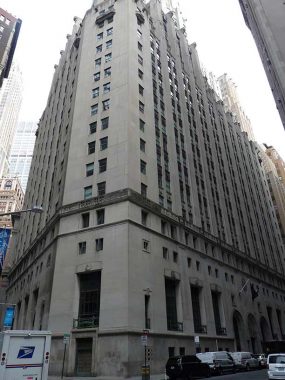
When constructed for the City Bank-Farmers Trust Company by Cross & Cross in 1931, #20 Exchange Place was one of the world’s tallest buildings at 57 stories. I didn’t have enough room to capture its total height in the tight spaces of the Financial District. Its granite and limestone exterior covers a steel superstructure. It has entrances on all four of its sides on Beaver, William and Hanover Streets and the main one on Exchange Place.
I was especially fascinated by the medallions surrounding the arched Exchange Place entrance, representing the 11 countries where City Bank Farmers Trust operated offices. To me, the medallion depicting the USA, with a Native American profile, closely resembles the “Indian head” or “Buffalo”nickel, struck between 1913 and 1938, designed by designed by sculptor James Earle Fraser. It’s my favorite coin (and I’m glad I never got into coin collecting, since I wouldn’t have time for Forgotten NY).
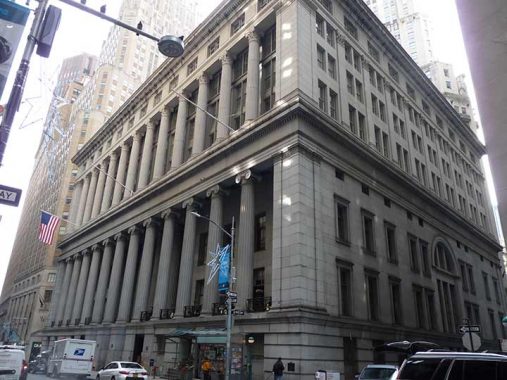
After the original Merchants’ Exchange Building burned down in the great fire of 1835, this magnificent colonnaded building t #55 Wall Street and William was constructed beginning in 1836. It was later used as NYC’s Customs House and remodeled and doubled in height from 1907-1910 after the big Bowling Green Customs House building was constructed, and it became the headquarters of the First National City Bank, now called Citibank (Citigroup). Presently it is occupied by the ritzy restaurant Cipriani and the Cipriani Club Residences.
The HQ of the Bank of New York & Trust Company is a 1928 building designed by Benjamin Wistar Morris, crowned with a Corinthian temple and a bronze eagle (invisible from Wall Street). The “magnificent” central banking room, seen from the large arched exterior windows, is a “special and serene space” (AIA Guide). Converted to condos in 1999; the banking floor is now the Museum of American Finance, an affiliate of the Smithsonian.
The cornerstone of the original Bank of New York building can be seen here.
The Bank of New York was founded on June 9, 1784, making it the oldest bank in the United States. Alexander Hamilton wrote the new bank’s constitution, and became the individual most actively involved in the organization of The Bank of New York, guiding it through its early stages. The bank opened for business at the Walton House in Lower Manhattan only a few months after the departure of British troops from American soil. It opened with a capitalization of $500,000. William Seton, future father-in-law of Saint Elizabeth Seton, was named director in 1786. BONY merged with Mellon Financial Corporation on July 2, 2007.
The entrance to the #2, 3 trains Wall Street station here is nonstandard, with bronze plaques stating “Interborough Rapid Transit”; the original “IRT’ opened from City Hall to 145th Street in 1904 and quickly expanded thereafter; these days, it takes decades to build just 4 stations. Today, the former “IRT’ can be recognized by numbered trains from 1 to 7.

Our Lady Of Victory Roman Catholic Church, serving the many Catholic office workers in the area and an increasing number of downtown residents, is a relatively new addition to the north side of Pine at William Street, having been completed in 1946. It was founded by Francis Cardinal Spellman in 1944 and is also known as the War Memorial Church.
As is known by frequent FNY readers, I find the International Style, basically glass-exterior towers, pretty boring, but it’s been acclaimed by architectural critics and today, nearly 70 years into it, still represents the go-to style for new office buildings and residential towers. One Chase Manhattan Plaza (#28 Liberty), at the NW corner of William, is a prime representative of the style. It was completed in 1964 by Skidmore, Owings and Merrill and the architects Jacques Guitton and Gordon Bunshaft (the designer of Lever House on Park Avenue, which helped kick off the International movement).
David Rockefeller Plaza (a.k.a. Fosun Plaza, after a Chinese investment company that purchased it from JP Morgan Chase) features sculptor Jean Dubuffet’s 1972 “Group of Four Trees.”
The lion and the unicorn appear in heraldic coats of arms and symbolize England and Scotland the United Kingdom. So, what are they doing on this corner clock above the third floor at #84 William Street at Maiden Lane, a.k.a The Howell, a building containing expensive apartments? The building was constructed in 1907 for the offices of the Royal Life Insurance Company, based across the pond.

Sculptor Louise Nevelson resided at #222 East 7th Street in the East Village, which received a bottom to top makeover some years ago. Nevelson’s 1978 installation, Shadows and Flags, can be found at Louise Nevelson Plaza, Maiden Lane and Liberty and William Streets in the Financial District.
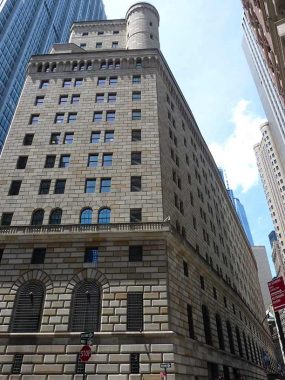
Wedged between Liberty, William and Nassau Streets and Maiden Lane is the Federal Bank Reserve of NY Building [York & Sawyer, archs], completed in 1924 and consisting of Indiana limestone and Ohio sandstone. Five stories are below street level with subterranean vaults, containing the gold reserves of many nations, resting on bedrock. There is more monetary worth stored here (over $90B) than in Fort Knox, Kentucky. The bank is the foremost in the dozen that make up the Federal Reserve System.
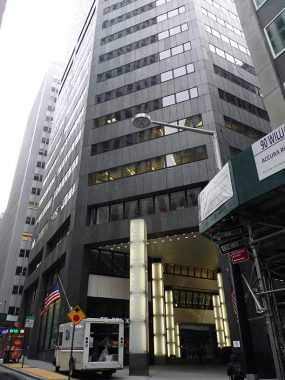
To contrast the sensibilities of architects in different decades, here’s #100 William at Platt Street, built in 1973.

In 1942, the Fidelity and Deposit Company of Maryland succeeded in building a 7-story center that looked 20 years older than it actually was. Today the building hosts Pace university and other offices. The “FD” digraph can still be seen on the pediment above the Ionic columns.

#100 Fulton, on the SW corner of William, is not landmarked and so is relatively unchronicled at least in what is readily available to me. It was constructed in the first decade of the 20th Century, and has a subway entrance to the #2 and 3 trains on the William Street side.
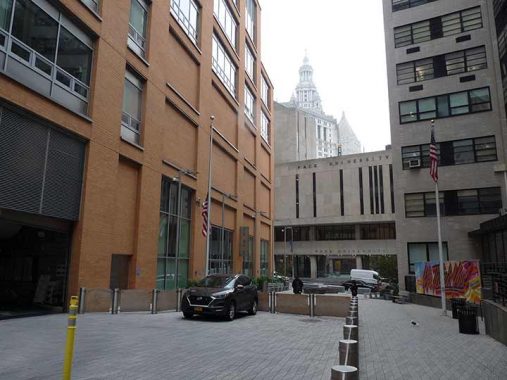
The northernmost block of William Street between Beekman and Spruce Streets is closed to traffic. On the left is the ground floor of #8 Spruce Street, designed by Frank Gehry; for a few years it was the tallest residential building in the world. On the right is the downtown branch of NY-Presbyterian Hospital, opened in 1953. Just ahead is Pace University, with the spire of the Municipal Building in the background.
As always, “comment…as you see fit.” I earn a small payment when you click on any ad on the site.
4/9/23



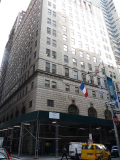
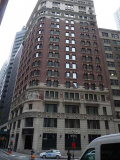
9 comments
That subway entrance looks just like the one the lion in the Dreyfus Fund commercial
came up out of back in the 1960s.He walks around the streets,no one pays him any mind.
My Dad said he was a specially trained lion like they got in the circus.
I’ve got your Dreyfus Fund ad for you, right here, Chris:
https://www.bing.com/videos/search?q=Dreyfus+mutual+fund+tv+ad+with+loin&docid=603528898950613197&mid=D3B58F33D2FE3F96D292D3B58F33D2FE3F96D292&view=detail&FORM=VIRE
The outfit I worked for was headquartered at 110 William St for several years before I joined; it then moved to the original world trade center in 1973. I came on board in 1974 & then in early 1980, due to the success of the WTC we had to move back to 110 William St., which was literally & figuratively a comedown. The next move, to Gertz Plaza in Jamaica in 1985, looked like a comedown but it worked ( no more public
transportation for me!). I hope that the Dreyfus lion had a long, prosperous life.
My dad worked at 110 William, 14th Fl in the 70s
I probably encountered him in the very crowded elevator at one point. Small world, Tom.
According to Eugene Armbruster, John and Peter Delmonico were wildly successful with their coffee and confectionery shop which led to their opening of an Italian and French restaurant in 1831. That too was very successful.
With his wealth John Delmonico purchased a country estate in the Eastern District of Kings County (Brooklyn) and decorated it with paintings and scriptural pieces.
In November of 1842.John Delmonico went on a deer hunting trip to the Snediker property on Long Island While on a stand he shot and wounded a deer which was put down at the next stand. When his buddies went to get him, they found him dead. His passing was explained as “apoplexy” due to the excitement. of shooting the animal.
John’s brother Peter and a nephew, Lorenzo, continued the business.
Thanks again Redstaterefugee.The ad bought back memories.For some reason some ads just stick
in your mind forever.Maybe it was because my father was a Mad Man.
Chris: You could write a very interesting memoir about being the son of a Mad Man who chose a seagoing career instead of “three martini lunches. I salute you.
I appreciate the appreciation RedStateRefugee but I only went to sea for about 2 years.My Dad on the other hand was in advertising
from the late 40s till about 1987.I never understood its appeal to him.Who ever remembers any commercials or magazine ads?Very
few people.And my grandmother used to always go on about what a “backstabbing” business it was.I should have asked her to elaborate.
Just an observation, but the Indian / Buffalo nickel shown among the other medallions has LIBERTAS in place of LIBERTY used on the actual coin.